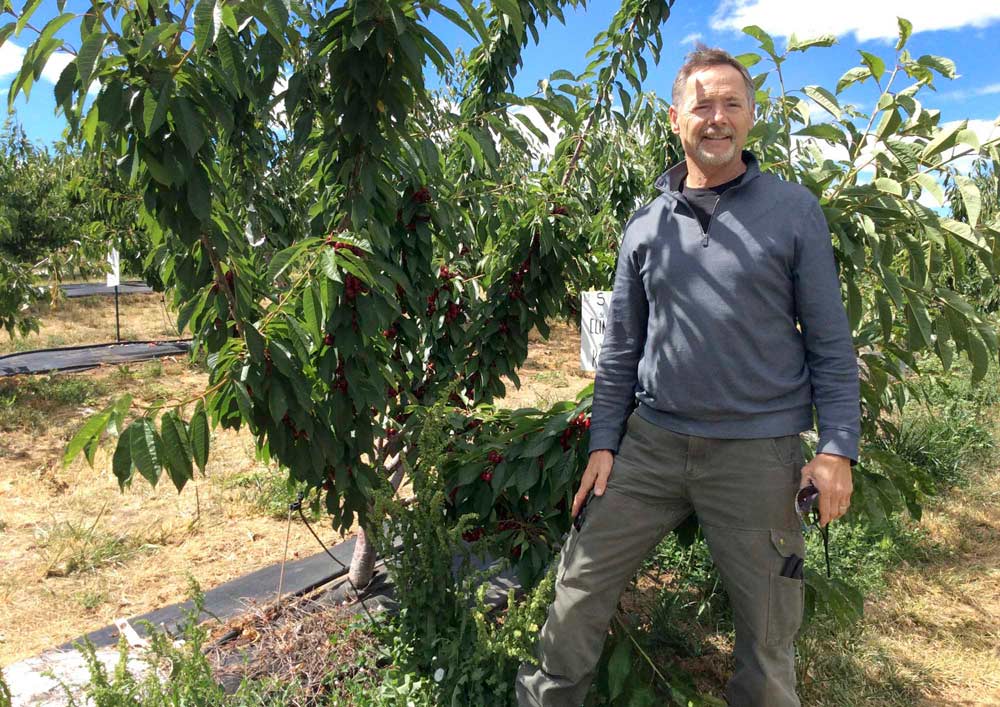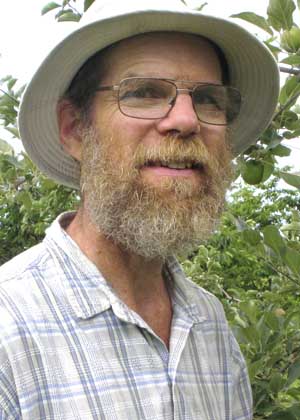
Grower Tim Dahle of The Dalles, Oregon, says there are advantages that come from having test plots in his orchards. “We do it to learn and develop best practices — that’s the No. 1 thing. And there is some value in being the first to learn some of these practices.” (Courtesy Dahle Orchards)
Test plots not only take up space in the orchard, but they also require an investment of time. With that in mind, why should a grower participate?

Brad Phillips
Good Fruit Grower asked growers Tim Dahle of The Dalles, Oregon, and Brad Phillips of Berlin Heights, Ohio, why they do it year after year and what they get out of the experience.
Dahle is the owner of the 400-acre Dahle Farms, which specializes in sweet cherries and pears. He has been running test plots in his orchards for about two decades and generally has about 2 percent of his land in test plots. Phillips is the owner of A.B. Phillips & Sons Fruit Farm, which grows apples, peaches, sweet and tart cherries, pears and grapes on 20 acres. He began running test plots in 2011, and he now has about 2 percent of his orchards in testing.
Good Fruit Grower: What is being tested in your plots?
Dahle: Our current focus is on varieties, rootstocks, systems and a growth regulator. We have hosted plots to study the benefits of mycorrhizae, nutrients, growth regulators, irrigation regimes, fumigation methods, etc., (and) we have independently researched composts, mulches and growth regulators.
Phillips: My test plots are always for new apple varieties under study by the Midwest Apple Improvement Association (MAIA).
Good Fruit Grower: Why do you agree to have test plots in your orchards?
Phillips: I’m also the chair of the science committee for MAIA, and I’m strongly committed to the MAIA and its mission, which is to create varieties that are adapted to our region and that explore new and interesting apple flavors and textures for the consumer. When the MAIA asked me to plant test trees, I said “sure.” Some of the reasons I do it is because we can see how they grow on our farm, we can see their good points and bad points, and we can say early on whether we would really like to plant this one or we aren’t sure about that one. It puts us ahead of the game.
Besides that, even though most of my test trees are only 3 to 4 years old, I get enough apples to pass out samples to people who come to farmers’ markets or who stop in the barn. That gives me immediate consumer feedback that I can take back to the MAIA. After all, the MAIA’s final goal is to make apples that people want to eat. There’s no point in growing something that’s easy for you to grow if nobody wants to eat it.
Dahle: We do it to learn and develop best practices — that’s the No. 1 thing. And there is some value in being the first to learn some of these practices. Of course, when participating with a university researcher, the results become public pretty quickly.
Good Fruit Grower: Thinking about the test plots you’ve had, do any stand out as being notable?
Dahle: The systems trials have been quite beneficial because they’ve helped us to develop a system that was the right fit for us. Also, test plots for rootstocks and varieties have been helpful in allowing us to see several rootstocks side by side and with different fruit varieties on top. That has helped us make more correct decisions in the orchard. And those are big decisions: getting the right combination of rootstock and variety for your particular location is key to success.
Phillips: I had the EverCrisp in my test plot before it was a named variety, and that’s an excellent variety that’s going to become well known as the production ramps up. I also have one called Sweet Zinger in my test plot. The MAIA just released that one, and I’ve come to recognize that as a very good variety.
Good Fruit Grower: What advice would you give growers who are thinking about signing up to participate in a test plot?
Dahle: Be prepared to see the project through and honor your commitments to the researcher. One must be mindful that the researcher is invested in this project and needs to complete it with a complete and accurate dataset, because that’s the basis of his funding.
That said, not all research is something you should act on. Try to focus on things that are important to you and your industry. A project should be practical for you to take on and do it well.
Good Fruit Grower: What recommendations do you have for growers once they decide to run a test plot?
Phillips: My advice would be to put the test plot close to the house, so you can get out and take a look at it. If you put it way out in the back of the farm, you’re never going to see it and it won’t get the attention it needs. In other words, grow them as though they are very valuable trees, because they are. They need to be taken care of just like your other varieties so you can give them a fair evaluation.
Also, you’ve got to have patience when testing a new variety. It’s easy to draw conclusions from really young trees, but that’s really not a proper evaluation of what that tree can do. This is a long-term process, and you have to keep looking at trees for many years.
And finally, pay attention to record-keeping and details. For instance, keep walking the orchard and sampling to see when they’re ready to harvest, and then add a flag with the harvest timing so you don’t have to relearn it every year. And be sure to send any collected data back to whatever group you’re working with. We’re all really busy at harvest time, but it’s important.
Good Fruit Grower: So overall, it sounds like test plots are not only good for the individual grower, but for the greater grower community as well.
Phillips: Absolutely. The MAIA is a mainly grower-run co-op with members throughout the Midwest, down to Virginia and Kentucky, and even out in Washington state, so it’s important to have multiple growers test new varieties to see how they do in different areas.
Dahle: My primary motive for participating in test plots is to develop the best technology and practices for our farm, but it does feel good to be part of research that is helping the industry and our region. •
—by Leslie Mertz






Leave A Comment